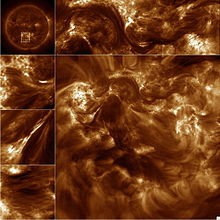High resolution coronal imager
The High Resolution Coronal Imager (Hi-C) is a suborbital telescope that was built to take high resolution images of the solar corona . It was launched on July 11, 2012 aboard a sounding rocket from the White Sands Missile Range in New Mexico .
mission
The telescope weighs 210 kilograms and took 165 images during its short 620-second flight.

